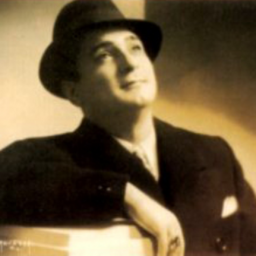
Хотите запечатлеть незабываемые моменты? Доверьте свои фотографии профессионалу! Услуги талантливого фотографа - гарантия качественных снимков и восхитительных портретов.
Тексты песен Carlo Buti
Ничего не найдено.
Информация о артисте
Карло Бути (Флоренция, 14 ноября 1902 - Montelupo Fiorentino, 16 ноября 1963) - итальянский певец, "золотой голос Италии".
Родился Бути неподалёку от Флоренции. Мальчиком, он овладел народной тосканской техникой пения "stornello" и вскоре начал зарабатывать деньги исполнением серенад.
Бути также обучался вокалу у Рауля Фрацци и Джино Беки. Звучал на итальянском радио и записывался на Edison Records начиная с 1930, а с 1934 - на Columbia Records.
Бути называли "итальянским Фрэнком Синатрой"...
Он перестал выступать в 1956, записав в общей сложности 1574 песни. Это был рекорд в истории итальянской поп-музыки. Его уникальный тёплый и мелодичный стиль "tenorino", исполняемый вполголоса как бы фальцетом, принёс ему мировую популярность. Также он снялся в нескольких итальянских кинофильмах.
Умер Карло Бути в Монтелупо Фиорентино в Тоскане в возрасте 61 года. Read more on Last.fm. User-contributed text is available under the Creative Commons By-SA License; additional terms may apply.
Родился Бути неподалёку от Флоренции. Мальчиком, он овладел народной тосканской техникой пения "stornello" и вскоре начал зарабатывать деньги исполнением серенад.
Бути также обучался вокалу у Рауля Фрацци и Джино Беки. Звучал на итальянском радио и записывался на Edison Records начиная с 1930, а с 1934 - на Columbia Records.
Бути называли "итальянским Фрэнком Синатрой"...
Он перестал выступать в 1956, записав в общей сложности 1574 песни. Это был рекорд в истории итальянской поп-музыки. Его уникальный тёплый и мелодичный стиль "tenorino", исполняемый вполголоса как бы фальцетом, принёс ему мировую популярность. Также он снялся в нескольких итальянских кинофильмах.
Умер Карло Бути в Монтелупо Фиорентино в Тоскане в возрасте 61 года. Read more on Last.fm. User-contributed text is available under the Creative Commons By-SA License; additional terms may apply.
Carlo Buti (Florence, November 14, 1902 - Montelupo Fiorentino, November 16, 1963) was an Italian singer known as "the Golden Voice of Italy."
Buti was born near Florence. As a boy, he mastered the Tuscan folk song technique known as "stornello". He ws soon being paid by other men to serenade their girlfriends. He received limited vocal training from Raoul Frazzi and Gino Bechi. He was featured on Italian radio and recorded for Edison Records starting in 1930, but went to Columbia Records by 1934.
Buti has been called the "Frank Sinatra of Italy", because of his preference for the popular songs of the day over the more operatic songs. He retired in 1956 after having recorded 1574 songs[1]. At the time, he was the most recorded voice in Italian music history. His unique warm and melodic "tenorino" style of high quasi-falsetto phrasing sung in the "mezza voce" made him an international success. He also starred in several Italian movies. He passed away at his home in Montelupo Fiorentino, in Tuscany, Italy at the age of 61. Read more on Last.fm. User-contributed text is available under the Creative Commons By-SA License; additional terms may apply.
Buti was born near Florence. As a boy, he mastered the Tuscan folk song technique known as "stornello". He ws soon being paid by other men to serenade their girlfriends. He received limited vocal training from Raoul Frazzi and Gino Bechi. He was featured on Italian radio and recorded for Edison Records starting in 1930, but went to Columbia Records by 1934.
Buti has been called the "Frank Sinatra of Italy", because of his preference for the popular songs of the day over the more operatic songs. He retired in 1956 after having recorded 1574 songs[1]. At the time, he was the most recorded voice in Italian music history. His unique warm and melodic "tenorino" style of high quasi-falsetto phrasing sung in the "mezza voce" made him an international success. He also starred in several Italian movies. He passed away at his home in Montelupo Fiorentino, in Tuscany, Italy at the age of 61. Read more on Last.fm. User-contributed text is available under the Creative Commons By-SA License; additional terms may apply.
Альбомы артиста:
Похожие артисты:
Ничего не найдено.
